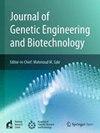Alternative therapeutic approaches for combating multi-drug-resistant bacteria: Reverse vaccinology against Enterobacter cloacae
IF 3.5
Q3 Biochemistry, Genetics and Molecular Biology
Journal of Genetic Engineering and Biotechnology
Pub Date : 2025-06-17
DOI:10.1016/j.jgeb.2025.100519
引用次数: 0
Abstract
Enterobacter cloacae is a clinically significant opportunistic and multidrug-resistant bacterium that causes a range of hospital-acquired infections, particularly in intensive care units. However, studies on vaccine development have been limited, and no vaccine currently protects against E. cloacae. Here, we employed subtractive proteomics, reverse vaccinology, and immunoinformatic approaches to design a multi-epitope-based vaccine targeting E. cloacae. Analysis of 21 complete E. cloacae genomes associated with human infections revealed 1,352 proteins linked to essentiality, resistance, and/or virulence, 39 of which were non-human and non-gut homologs. From this refined selection, 9 were found to be antigenic, extracellular, or exported to the outer membrane and used to construct 4 multi-epitope vaccines (VEC1-4) containing antigenic (threshold of ≥0.5), non-allergenic, conserved, hydrophilic (GRAVY < 0), exposed, and non-toxic epitopes. They were all processed and presented through the MHC class pathway, while also showing high population coverage. VEC1 showed the most consistent performance, with the highest average binding affinity (−24.07 kcal/mol), docking score (−322.21), and the most favorable dissociation constant at 37 °C. VEC1 was shown to be conformationally stable, with a secondary structure predominantly made up of alpha-helices and coils. The in silico analysis suggested that VEC1 can be efficiently expressed in an E. coli system, and it is currently awaiting in vivo testing to confirm its precise efficacy, safety, and immunogenicity. These findings provide valuable insights for developing novel approaches to prevent and control the spread of multidrug-resistant bacteria.
对抗多重耐药细菌的替代治疗方法:针对阴沟肠杆菌的反向疫苗学
阴沟肠杆菌是临床上重要的机会性和多重耐药细菌,可引起一系列医院获得性感染,特别是在重症监护病房。然而,疫苗开发的研究有限,目前还没有疫苗可以预防阴沟肠杆菌。在这里,我们采用减法蛋白质组学、反向疫苗学和免疫信息学方法设计了一种针对阴沟肠杆菌的基于多表位的疫苗。对与人类感染相关的21个完整的阴沟肠杆菌基因组进行分析,发现1352个与必要性、耐药性和/或毒性相关的蛋白质,其中39个是非人类和非肠道同源物。从这一精细选择中,9个被发现是抗原的,细胞外的,或输出到外膜,并用于构建4个多表位疫苗(VEC1-4),含有抗原(阈值≥0.5),非过敏性,保守,亲水性(GRAVY <;0),暴露的,无毒的表位。它们都是通过MHC类途径加工和呈现的,同时也显示出很高的人群覆盖率。VEC1表现出最一致的性能,其平均结合亲和力最高(−24.07 kcal/mol),对接评分最高(−322.21),37℃时解离常数最高。VEC1的构象稳定,二级结构主要由螺旋和线圈组成。计算机分析表明,VEC1可以在大肠杆菌系统中高效表达,目前正在等待体内试验来证实其确切的有效性、安全性和免疫原性。这些发现为开发预防和控制耐多药细菌传播的新方法提供了有价值的见解。
本文章由计算机程序翻译,如有差异,请以英文原文为准。
求助全文
约1分钟内获得全文
求助全文
来源期刊

Journal of Genetic Engineering and Biotechnology
Biochemistry, Genetics and Molecular Biology-Biotechnology
CiteScore
5.70
自引率
5.70%
发文量
159
审稿时长
16 weeks
期刊介绍:
Journal of genetic engineering and biotechnology is devoted to rapid publication of full-length research papers that leads to significant contribution in advancing knowledge in genetic engineering and biotechnology and provide novel perspectives in this research area. JGEB includes all major themes related to genetic engineering and recombinant DNA. The area of interest of JGEB includes but not restricted to: •Plant genetics •Animal genetics •Bacterial enzymes •Agricultural Biotechnology, •Biochemistry, •Biophysics, •Bioinformatics, •Environmental Biotechnology, •Industrial Biotechnology, •Microbial biotechnology, •Medical Biotechnology, •Bioenergy, Biosafety, •Biosecurity, •Bioethics, •GMOS, •Genomic, •Proteomic JGEB accepts
 求助内容:
求助内容: 应助结果提醒方式:
应助结果提醒方式:


